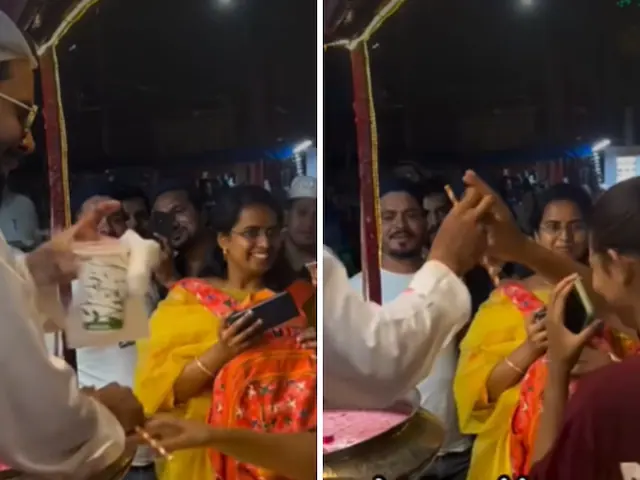Introduction
In the age of social media, videos and images can quickly go viral, sparking debates and discussions on various topics. One such video, showing a street food vendor dressed in a Kandura serving sharbat, has recently gained significant attention. The video has led to a heated debate about cultural appropriation, respect, and the blending of traditions. This blog post aims to provide a comprehensive analysis of the incident, exploring the cultural implications, public reactions, and expert opinions.
The Viral Video on Street Food Vendor

The video in question features a street food vendor in India, dressed in a Kandura, preparing and serving sharbat to customers. The stark contrast between the vendor’s traditional Emirati attire and the typical street food setting has elicited a range of responses from viewers. The video, which has been widely shared on social media platforms like Twitter, Instagram, and Facebook, has garnered millions of views and sparked a lively debate.
The initial reactions to the video were mixed. Some viewers appreciated the vendor’s unique attire and the cultural blend it represented, while others were critical, viewing it as a form of cultural appropriation. The debate highlights the complexities of cultural exchange and the importance of understanding and respecting the significance of traditional attire.
Cultural Significance of the Kandura
The Kandura, also known as a dishdasha, is a traditional garment worn by men in the United Arab Emirates and other Arab countries. It is an ankle-length robe, usually white, symbolizing purity, dignity, and cultural heritage. The Kandura is typically worn during important events, religious ceremonies, and daily life by Emirati men. It is a symbol of national pride and cultural identity.
The Kandura’s significance extends beyond its physical appearance. It represents a connection to heritage and tradition, embodying the values and customs of the Arab world. Wearing the Kandura in contexts outside its cultural origins, especially in informal settings like street food vending, can be seen as either a sign of cultural appreciation or disrespect, depending on the circumstances and intent.
The Sharbat Tradition
Sharbat is a popular traditional drink in India, known for its refreshing and sweet taste. It is often made from fruits, flowers, or herbs and served chilled, especially during the hot summer months. Sharbat holds cultural significance in Indian hospitality, symbolizing warmth, generosity, and the spirit of sharing.
In many Indian cities, street food vendor selling sharbat are a common sight, reflecting the vibrant and diverse street food culture. These vendors play a crucial role in providing affordable and accessible refreshments to the public. The preparation and serving of sharbat by a street vendor is a cherished tradition, representing the essence of Indian street food.
Public Reactions
The public reaction to the video was divided, reflecting a range of opinions on cultural appropriation and respect:
- Supportive Views: Some social media users praised the vendor’s attire, viewing it as a positive example of cultural fusion. They argued that the wearing of the Kandura should not be confined by geographical boundaries or specific social contexts. Supporters saw it as a celebration of cultural diversity and an innovative way to attract customers.
- Critical Views: Others expressed concern that the vendor’s use of the Kandura was disrespectful to its cultural significance. Critics argued that wearing the Kandura in a street food setting trivializes its importance and could be seen as cultural appropriation. They stressed the need for cultural sensitivity and respect for traditional garments and their meanings.
The debate on social media highlighted the complexities of cultural exchange and the fine line between appreciation and appropriation. While some viewers saw the vendor’s attire as a bridge between cultures, others viewed it as a potential misrepresentation of cultural values.
Expert Opinions
Experts in cultural studies and sociology provided insights into the controversy:
- Cultural Fusion vs. Appropriation: Dr. Ayesha Khan, a cultural anthropologist, emphasized the importance of context when it comes to cultural attire. She noted that cultural fusion can be enriching, but it is crucial to understand and respect the origins and significance of traditional garments. Dr. Khan highlighted that while cultural exchange can promote diversity, it should not come at the expense of trivializing or misrepresenting cultural symbols.
- Intent and Respect: Sociologist Dr. Rajeev Menon highlighted the role of intent in such situations. He explained that if the vendor wore the Kandura with respect and an understanding of its cultural value, it could be seen as a positive gesture. However, if the attire was worn without awareness or consideration of its significance, it could be viewed as disrespectful. Dr. Menon stressed the importance of education and awareness in promoting respectful cultural exchanges.
Both experts agreed that cultural sensitivity is key in navigating such situations. They emphasized the need for open dialogue and education to foster mutual respect and understanding between cultures.
Addressing the Controversy
To address the controversy and promote respectful cultural exchanges, it is essential to consider the following points:
- Cultural Sensitivity: Individuals should strive to understand the cultural significance of attire and traditions before adopting them. This involves researching and appreciating the history, values, and customs associated with traditional garments.
- Open Dialogue: Encouraging open and respectful dialogue about cultural practices can help bridge gaps and foster mutual respect. Engaging in conversations with members of different cultures can provide valuable insights and promote understanding.
- Educational Initiatives: Public awareness campaigns and educational initiatives about cultural significance can reduce misunderstandings and promote appreciation for diversity. Schools, community organizations, and media platforms can play a vital role in educating the public about the importance of cultural sensitivity.
Conclusion
The viral video of the street food vendor dressed in a Kandura serving sharbat has sparked an important conversation about cultural respect and appropriation. While opinions are divided, the key takeaway is the need for cultural sensitivity and understanding. By fostering dialogue and education, we can appreciate the richness of diverse cultures while respecting their traditions and significance.








